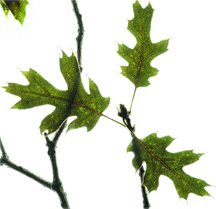 The Tibetan plateau,
home to the Himalaya, is the highest and largest topographic feature on Earth.
Its uplift over the past 20 million years has influenced climate by shaping
air masses and driving the Asian monsoons. Although geologists know its height
today, what is less certain is its elevation at various times in the past —
which would tell scientists how fast the plateau rose and, therefore, something
about what processes were going on far below the crust. A new method, however,
using the stomata, or breathing pores, on fossilized leaves may have promise
in constructing the past heights of the landscape.
The Tibetan plateau,
home to the Himalaya, is the highest and largest topographic feature on Earth.
Its uplift over the past 20 million years has influenced climate by shaping
air masses and driving the Asian monsoons. Although geologists know its height
today, what is less certain is its elevation at various times in the past —
which would tell scientists how fast the plateau rose and, therefore, something
about what processes were going on far below the crust. A new method, however,
using the stomata, or breathing pores, on fossilized leaves may have promise
in constructing the past heights of the landscape. These dried leaves of a California Black Oak, collected with permission from Mount Starr King in Yosemite National Park at an elevation of about 7,000 feet, are about an inch long each. The leaves become smaller at higher elevations, allowing scientists to correlate leaf characteristics to past elevations. Image by John Weinstein; courtesy of The Field Museum.
Several methods exist to calculate such “paleoelevations,” including looking at the size of gas bubbles in lava and the ratio of oxygen isotopes in sediment. But “there isn’t very much that’s sensitive to altitude,” says Peter Molnar, a geophysicist at the University of Colorado, Boulder, who studies the formation of mountain ranges. Additionally, these methods must all overcome the fact that very few physical processes react in a consistent way everywhere on the planet, he says. For example, proxies for elevation that depend on temperature, climate and latitude vary at different rates in different locales.
The new method, however, takes advantage of one factor that does change with elevation in a physically predictable way worldwide: the partial pressure of carbon dioxide in the atmosphere. “If you go up one kilometer in the atmosphere at the equator or one kilometer at the pole, you’ll see the same variation” in carbon dioxide, Molnar says, “whereas if you go up one kilometer at the equator, the temperature change is very different from that at the pole.”
At higher altitudes, plants tend to develop more stomata in order to better absorb the dwindling amounts of carbon dioxide for photosynthesis — a relationship that has been understood since the 1980s. Jennifer McElwain of Chicago’s Field Museum developed a technique that counts the number of stomata on a fossil leaf to determine the amount of carbon dioxide that was present in the atmosphere during its growth and, therefore, the altitude at which the plant grew, as she reported in the December Geology.
The study used samples of California Black Oak (Quercus kelloggii) because it grows at a wide range of elevations. Leaves collected in the 1930s for the museum’s herbarium were used to develop and test a formula relating stomatal density to changes in elevation. McElwain then applied the formula to a related species, Quercus pseudolyrata, to show that the method could be applied to species other than the one on which it was calibrated.
However, as McElwain notes, some recent studies have shown that stomatal response varies widely from species to species. Therefore, applying a formula calibrated on modern plants to an extinct species is a leap some are not keen on making.
“Where I see problems is the application to fossil sites,” says Robert Spicer, a paleobotanist at the Open University in Milton Keynes, in the United Kingdom, who also works on using fossil leaves to determine paleoelevation. Still, he says, “this is an interesting new approach that is worthy of further development.”
Molnar agrees, saying, “I think what she’s done is very clever.” He worries, however, that by using leaves of plants that are extinct, there’s no way to know for certain how the plants would react. “I see that as the Achilles’ heel, if there is one,” Molnar says.
Additionally, unlike the method Spicer works with, which relies only on the size and shape of fossil leaves, Spicer says that the use of stomata will require fossil material “to be very well preserved — at the level of preserving epidermal cell detail.” Such fossils, he says, are not easy to find. “I know of no Tibetan material that meets this criterion.”
Other methods of determining paleoelevation can have as much as 1,000 meters of error. McElwain reports the new method has an average uncertainty of 300 meters. Although Molnar and Spicer question such unusually low uncertainties, they both suggest comparing the new method to old ones. Such comparisons tend to yield good results, they say.
“All these methods have their problems,” Molnar says. Comparing them, however, may yield “some kind of confidence that we’re getting there.”
Sara Pratt
Geotimes contributing writer
Back to top

